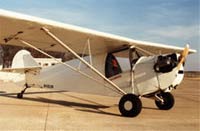
Stewart Headwind
The Little Homebuilt that Could
This is another of those is-it-an-airplane-or-is-it-a-model discussions because you don’t have to look too hard at a Stewart Headwind to see lots of both.
When Don Stewart decided he wanted to design and build an everyman’s airplane in 1962, he simply incorporated the features he liked most in some of his favorites, not all of which were real airplanes. A modeler of the old school, he had lots of cabin free flight models floating around in his head along with the basic aerodaynamics learned from those models.
Basically, what he had learned from his rubber free flighters was if you hang a long wing on a light airframe. you won’t need much in the way of power to make it fly well and he was hoping to fly it on a VW engine. The fuselage gives a slight nod to the Aeronca C-2 in it’s triangular shape, but Stewart says, if any airplane influenced him at all, it was the tiny Demoiselle by Santos Dumont from the very early days of flight. Mostly, he says, the Headwind was “…my airplane from start to finish.”
Stewart designed a cogged belt reduction unit for it the VW (he markets it as The Maximizer) that would allow it to turn at a high RPM to develop maximum horsepower but still keep the prop tips under supersonic speeds for maximum thrust. The bigger, slower turning prop gave the airplane much more thrust and takeoff performance turned out to be spectacular for the type. Incidentally, reportedly the Headwind was the first US design built around a VW, although European Jodels had been flying Veedubs.
Today, more than 40 years since he originally offered plans for the airplane, Stewart still offers not only the plans but complete CNC cut and drilled wood kits for the wings. When the box is opened, it looks for all the world as if you’re looking at a well done RC kit.
The fuselage is easy to build because there isn’t much of it and the triangular layout makes jigging quite easy. Yeah, you have to learn to weld, but that’s not as hard as it sounds.
Don doesn’t show it in his plans, but he says there is now a much wider range of engines that would adapt easily to his little airplane that might be better choices than a VW including the little 65 hp LOM Mikron (inverted, inline 4-cylinder).
At 80-85 mph, a Headwind isn’t exactly zipping cross country and, on a windy day, trucks are running away from you. Still, you have to remember that the primary reason most of us fly is simply that we like flying. So, if it takes longer to get there, that’s a plus not a negative.
Still there is that model airplane versus real airplane thing: If you consider a Headwind to be a scaled up rubber powered free flight and the ARF model being produced is a scaled down Headwind, does that make the Headwind a first generation model and the ARF kit a second generation or vice versa?
Go to www.stewartaircraft.com for more information.
Want another Peanut Pirep? Return to PEANUT.